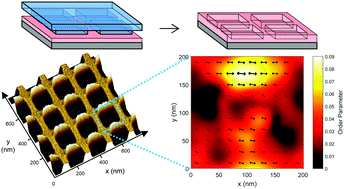Nanoscale deformation in polymers revealed by single-molecule super-resolution localization–orientation microscopy†
Abstract
Mechanical failure occurs through a hierarchical process, making it necessary to understand deformation at all length scales in order to develop advanced materials with, for example, enhanced toughness. This study addresses this challenge by demonstrating an optical imaging technique that detects damage at the nanoscale. We use single-molecule fluorescence microscopy experiments to simultaneously determine the position and orientation of single fluorophores from in-focus widefield images by fitting orientation-dependent point-spread functions determined by vectorial diffraction calculations. This capability is combined with switchable fluorophores in a single-molecule super-resolution microscopy scheme, enabling reconstruction of fluorophore orientation and alignment information at the nanoscale. We apply this method to polymer films deformed by thermal nanoimprint lithography, using fluorophore orientation mapping to detect areas of deformed material as small as 20 nm and distinguish them from neighboring, unperturbed regions. This technique advances the application of super-resolution microscopy in materials science, and may be applied to further the study of nanomechanical phenomena.



 Please wait while we load your content...
Please wait while we load your content...